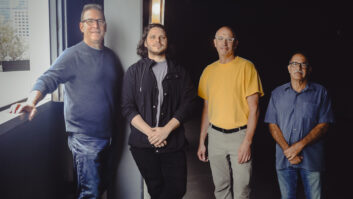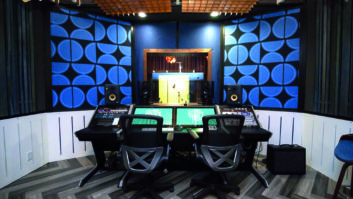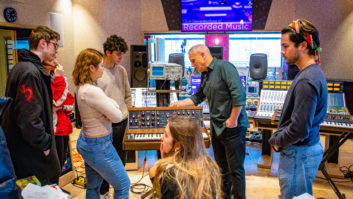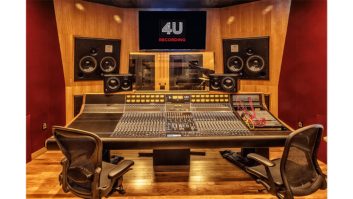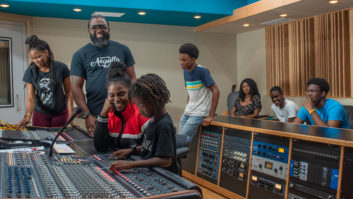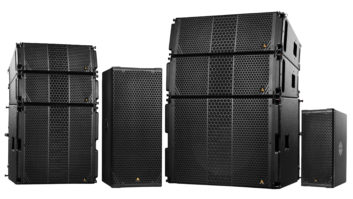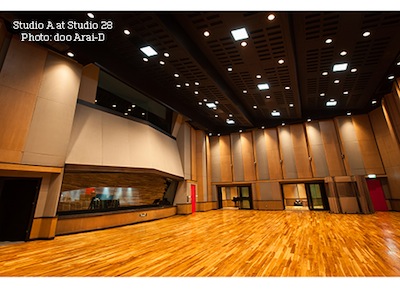

On the Cover: Studio A at Studio 28, Bangkok, Thailand
Jay Kaufman & Associates designed Studio A in this ground-up, 15,000-square-foot facility, which also includes a smaller B room, kitchen and lounges. With three adjacent iso booths and an observation deck, Studio A is large enough to accommodate projects ranging from rock bands to a 75-piece orchestra.
Studio 28 is owned by Fang Riewpakorn, who is from Bangkok but received her audio education in the U.S. “After I graduated from the recording program at Full Sail University, I moved to Los Angeles and worked as an intern for almost two years,” Fang says. “Then I decided to go back to Thailand and open the first version of Studio 28. It was a small studio for basic recording projects. After four years of doing mainstream and indie projects, our team decided to make a big change.”
Fang says that working in L.A. studios helped define what she ultimately wanted in this latest incarnation of Studio 28. She chose Kaufman to design it, in part because she admired his work on The Bridge Recording (Glendale, Calif.).
“Fang wanted the room to be very flexible,” Kaufman says. “She even had some interest in using the rooms for performance-type sessions with an audience in the room. So, we needed to have a pretty sophisticated variable acoustic system.
“The room’s character was designed to be warm yet detailed, with significant diffusion, which allows the players to hear each other clearly,” Kaufman continues. “To accommodate the need to control the room’s reverb time, about 40 percent of the walls can be reflective or absorptive by manually moving panels. The ceiling has motorized panels, which also allows for approximately 40 percent of the surface to be hard or soft. A critical component of this design was keeping the low-frequency reverb time in balance as the absorptive panels were engaged.”
Studio A’s 600-square-foot control room is equipped with an 80-channel SSL 9000J console that came from Electric Lady in New York, as well as K&A custom monitors, and a wide selection of outboard processing and microphones. Studio A has been open for about four months, and has already seen several sessions with the Bangkok Symphony Orchestra, Grammy-nominated bass player Nathan East and others.
Kaufman says he conducted a lot of his supervision on this project from a distance, with the help of Skype and a local project manager who consulted with him daily. He was able to test and tune the room in person at strategic intervals, but is still looking forward to hearing the finished studio, which Fang says she appreciates for its “simplicity and functionality. It sounds amazing and looks really professional.”

Katara Studios, Doha, Qatar
Katara Studios, another large international recording studio to open in the past year, was designed by the Walters Storyk Design Group in collaboration with Elie Wakim, head of the acoustical division of Doha-based Imar Trading & Contracting. The sprawling, 65,000-square-foot, 40-plus-room complex includes the beautiful 3,000-square-foot Studio 1 pictured here. This orchestra-ready room has a 30-foot ceiling and accommodates more than 80 musicians. Katara also features three control rooms, six iso booths and four sound locks. Control Room One is outfitted with a 96-fader Neve 88RS Console and 5.1 PMC BB5 surround sound monitoring. Studio 2 is a live band-tracking room with an adjacent 582-square-foot lounge that was designed to do double-duty as a third live room for smaller ensembles. The facility also includes a mastering suite, Dolby Atmos-equipped film post-production/mixing suite, two composer rooms, and three audio prep rooms. Interiors were designed by WSDG company co-principal Beth Walters, and partner/art director Silvia Molho performed extensive research on Islamic and Muslim graphic arts and architecture in order to incorporate elements of intricately patterned calligraphy and mosaics throughout the complex.

Shochiku MediaWorX Studios, Tokyo, Japan
Studio bau:ton and nonzero\architecture’s approach to the design of this post-production studio took into account the range of work accomplished in the facility, from traditional Kabuki theater and historic-film restoration to contemporary film production. The designers took inspiration from the slatted wood walls and panels common to traditional Japanese architecture. Also repeated throughout the project is a rectangular shape with a two-to-one ratio, a design element borrowed from tatami mats; these panels were divided diagonally to create two triangles, rendered in wood and fabric-covered panels as well as translucent Plexiglas. The Audio 1 Suite pictured here includes an Avid D-Control console, Pro Tools HD, Adam Audio mains and surrounds with Genelec 7270A subwoofer, and a range of plug-in processing.


Conclave Studios, New York City
This music production studio features design and system integration by the Malvicino Design Group. All interiors and acoustic treatments were manufactured by TADI. Specializing in rock, prog and metal recording and mixing, Conclave includes a 22×14-foot live room with 12-foot ceilings, as well as an adjacent iso booth and 23×18-foot control room. Situated in a New York City landmark building in the Chelsea area, the studio boasts incredible views of the Hudson River. Equipment includes a 24-channel Neve Genesys console with 1073 preamps and 1084 EQs; Pro Tools HDX2 and Logic Pro systems; monitoring from Yamaha and Genelec; and outboard gear from Empirical Labs, Lexicon, Focusrite, Radial and Trident.


The Orchard, New York City
Francis Manzella of FM Design Ltd. designed this music production and mixing studio to serve artists across multiple genres, from The Orchard’s affiliated record labels (Frenchkiss, Daptone, Instant Records, among others). This facility is equipped with an SSL AWS console, Genelec 1038 monitoring, Pro Tools HD, and a variety of analog outboard processing.


Sony PlayStation Studios, Playa Vista, Calif.
The game giant’s newest audio facility, designed by Chris Pelonis of Pelonis Sound & Acoustics, includes nine studios and six audio production suites, all with variable acoustics. All rooms were designed and optimized for stereo to 7.1 playback. A sizable recording suite within the facility features an array of boutique analog gear, along with an Avid System 5 console. Each control room includes Pelonis Signature speaker systems.

Windy Hill Studios, Austin, Texas
Designed by Mark Genfan of Acoustic Spaces, this 2,000-square-foot facility in the Texas Hill Country offers a relaxing environment that feels removed but is minutes away from the city. Included are an 850-square-foot tracking room with 16-foot ceilings, as well as an adjacent control room and separate iso booths. Genfan designed all custom acoustical treatments, which are contained within fabric and woodwork, built on-site by the owners. Control room mixing can be performed in 2.1 to 7.1 via Chris Pelonis PSS-110 and JBL speakers. Other featured equipment includes an API 1608 console, Pro Tools HDX and Sontec and API EQs.


Oak Hollow Recording, Oregon City, Ore.
Haverstick Designs transformed a 47×23-foot detached garage with dirt floors into this four-room recording studio with live room, control room, vocal booth and client lounge. Extensive isolation was added to the structure, including doors and seals provided by IsoStore. Acoustical treatments were custom-designed, with the exception of the rear-wall diffusers from Overtone Acoustics. Wiring, conduit, patch bays and mic panels were designed by West Coast Studio Services. The studio includes an SSL Matrix board, Pro Tools 12 HD, Dynaudio BM5A speakers and a wide range of mics and mic pre’s.


Deep River Sound Studios, Sanford, N.C.
Designed by the Wes Lachot Design Group to accommodate music recording and mixing, as well as music-for-film projects, Deep River Sound is the personal facility of owner/engineer John Davenport, whose credits include the Rolling Stones, Bruce Springsteen, John Lennon and others. The studio, which was built by Brett Acoustics and wired by Canova Audio, features ATC monitors and an API Legacy Plus console with automation, and was designed to have a control room sweet spot that covers the width of the board. Lachot states that critical mixing in the room is made possible by an even decay time and the highly diffuse rear portion of the room, as well as a unique diffsorptive ceiling cloud. The tracking room features variable acoustic panels that fold to reveal a 20-foot picture window overlooking Deep River.

Jukasa Post Production, Caledonia, Ontario
This high-end film mix studio was designed for Jukasa Post Production by Pilchner Schoustal International. The design incorporates a Dolby Atmos system using a Meyer Sound Acheron speaker system with 36 surround speakers, three main screen channels and seven subwoofers. Dolby and Meyer were both involved in the development of this theater. Acoustically, the design implements a sophisticated arrangement of room treatment constructs integrated into the room surfaces, along with other custom assemblies geared toward providing a spatially uniform and consistent system response. This facility also incorporates an Avid S6 control surface that interfaces with five Pro Tools systems, a Christie 4K projector and Stewart Directors Choice screen.


Rapid Eye Music, Belmont, Mass.
Built into a renovated two-story barn, Rapid Eye Music was designed by Lou Clark of Sonic-Space. In the control room—which is fitted with a Slate Raven MTi touch-screen console and Adam and JBL monitors—are concrete speaker stands within a 24-inch-deep broadband absorber; floor-to-ceiling side wall absorbers; three feet of ceiling bass trapping; and a rear wall bass trap with flush-mounted RPG Diffusors. At the speaker end of the room, the floor has a 24-inch-deep bass trap hidden behind carpet and a porous frame; the trap travels all the way to the opposite side of the room under the wood floors. The live room’s 14-foot ceiling has angled panels and duct liner used as ceiling tiles to control floor-to-ceiling reflections. Wall-mounted polycylindrical diffusers and theater curtains help to control and vary the acoustics.


The Parlor Recording Studio, New Orleans, La.
Designed and built from the ground up by Dave Mattingly of Sound Construction Inc., The Parlor is situated underneath a historic warehouse in New Orleans’ Irish Channel neighborhood. Included are an 800-square-foot control room, 1,100-square-foot tracking room, three iso booths, plus an echo chamber. Reflective surfaces in the studio are a combination of new materials (such as custom-milled and stained waveboard) and reclaimed materials (antique heart pine floors, mahogany trim, vintage bricks). Key equipment includes a Neve 8078 board restored by Vintage King Audio, Studer and Ampex tape machines, CLASP system, Pro Tools HDX, and Apogee converters, as well as plenty of vintage mics and band equipment.

Richards Outpost, Dallas, Texas
The Russ Berger Design Group helped to create this audio facility for the new 18-story headquarters of advertising/marketing agency The Richards Group. The complex, which includes two 5.1 control rooms and a shared recording booth, serves the agency’s in-house production and post work. Richards Outpost is equipped with Genelec DSP monitoring, an Avid ICON-D Command ES console controlling Pro Tools, and more.


Joachim Horsley’s Lookout, Los Angeles
Arranger/composer Joachim Horsley contracted with Steven Durr Designs to build this studio for acoustic and small-ensemble recording. Durr’s design focuses on providing a big, natural sound—especially for the studio’s 1875 Steinway grand—in limited space, on the second floor of Horsley’s home. The existing offset of the roof line was used to create a lofted recording space that accommodates live band sessions, which are captured via Pro Tools HD Native with Apogee Symphony I/O, Avalon and API preamps and Genelec surround monitoring.

SAE Institute, Los Angeles
Delta H Design’s proprietary Surface Mounted Device (SMD) and Quantum Acoustic nanotechnology systems were applied to 18 rooms of the School of Audio Engineering’s newest campus in L.A.’s historic Kodak building. The design firm spec’d its ZR screens on track systems to address the numerous windows in the rooms, stating that with the screens closed, ZR Micro technology embedded in the screens makes the window glazing undetectable. These new educational studios are fitted with a variety of gear, including consoles from SSL, Neve, Toft and Avid; and monitoring systems from Genelec, Dynaudio, Adam and Mackie.

Cool Springs Mix, Nashville
Carl Tatz Design handled the design of this personal mixing studio for engineer/producer Bob Bullock, whose credits include Reba McEntire, George Strait, Kenny Chesney and others. The facility incorporates Tatz’s MixRoom concept, featuring the PhantomFocus System monitoring technology. Acoustical treatments include a custom application of the Carl Tatz Signature Series acoustic modules by Auralex. Featured equipment comprises Dynaudio M1 monitors (in a PhantomFocus System), Pro Tools 11 and Nuendo 7, Avid MC Control, and Neve and API mic pre’s.

Sky Harbor Studios, Owatonna, Minn.
This private facility was designed by the Walters Storyk Design Group for Adam Young, a singer, composer, musician and creator/member of top-selling electronica project Owl City. Situated in Young’s log cabin home, the studio features a 675-square-foot control room outfitted with an SSL AWS console, Adam Audio S-4XV mains, and Young’s extensive collection of outboard gear. A rolling producer’s desk and four mobile equipment racks allow for flexible room reconfiguration. There’s also a 225-square-foot live room containing Young’s collection of instruments, and an adjacent 35-square-foot vocal booth. This studio’s natural wood construction fits beautifully with the cabin’s interior and exterior setting.

Mesa Recording Studios, Austin, Texas
Designed and built from the ground up by owner/producer Rob Hinton and Sean Eubanks of Woodhill Studios, Mesa Recording Studios is celebrating its grand opening after five years of planning and construction. Control Room A, pictured here, includes an SSL 4064 E/G+ console that was refurbished by the Desk Doctor and Pro Audio Design. The facility also contains a second control room, two additional tracking rooms, a full kitchen, saltwater pool and more, just 20 minutes southeast of downtown Austin.
